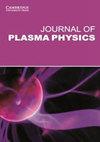Parallel expansion of a fuel pellet plasmoid
IF 2.1
3区 物理与天体物理
Q2 PHYSICS, FLUIDS & PLASMAS
引用次数: 0
Abstract
The problem of the assimilation of a cryogenic fuel pellet injected into a hot plasma is considered. Due to the transparency to ambient particles of the plasmoid, the localised region of high-density plasma created by ionisation of the ablated pellet material, electrons reach a ‘quasiequilibrium’ (QE) state which is characterised by a steady-state on the fastest collisional time scale. The simplified electron kinetic equation of the QE state is solved. Taking a velocity moment of the higher-order electron kinetic equation, which is valid on the expansion time scale, permits a fluid closure, yielding an evolution equation for the macroscopic parameters describing the QE distribution function. In contrast to the Braginskii equations, the closure does not require that electrons have a short mean free path compared with the size of density perturbations, and permits an anisotropic and highly non-Maxwellian distribution function. As the QE distribution function accounts for both trapped and passing electrons, the self-consistent electric potential that causes the expansion can be properly described, in contrast to earlier models of pellet plasmoid expansion with an unbounded potential. The plasmoid expansion is simulated using both a Vlasov model and a cold-fluid model for the ions. During the expansion plasmoid ions and electrons obtain nearly equal amounts of energy; as hot ambient electrons provide this energy in the form of collisional heating of plasmoid electrons, the expansion of a pellet plasmoid is expected to be a potent mechanism for the transfer of energy from electrons to ions on a time scale shorter than that of ion–electron thermalisation.燃料颗粒质点的平行膨胀
研究考虑了注入热等离子体的低温燃料颗粒的同化问题。由于等离子体对环境粒子的透明性,电子达到了 "准平衡"(QE)状态,该状态的特征是在最快碰撞时间尺度上的稳态。我们求解了 QE 状态的简化电子动力学方程。高阶电子动力学方程的速度矩在膨胀时间尺度上有效,它允许流体闭合,产生描述 QE 分布函数的宏观参数演化方程。与布拉金斯基方程不同的是,这种闭合不要求电子的平均自由路径与密度扰动的大小相比很短,而且允许各向异性和高度非麦克斯韦分布函数。由于 QE 分布函数同时考虑了被困电子和通过电子,因此可以正确描述导致膨胀的自洽电势,这与早期使用无约束电势的小球质点膨胀模型截然不同。我们使用 Vlasov 模型和离子冷流体模型模拟了质点膨胀。在质点膨胀过程中,离子和电子获得了几乎等量的能量;由于热环境电子以质点电子碰撞加热的形式提供能量,因此预计小球质点膨胀是一种有效的能量转移机制,其能量从电子转移到离子的时间尺度比离子-电子热化的时间尺度要短。
本文章由计算机程序翻译,如有差异,请以英文原文为准。
求助全文
约1分钟内获得全文
求助全文
来源期刊

Journal of Plasma Physics
物理-物理:流体与等离子体
CiteScore
3.50
自引率
16.00%
发文量
106
审稿时长
6-12 weeks
期刊介绍:
JPP aspires to be the intellectual home of those who think of plasma physics as a fundamental discipline. The journal focuses on publishing research on laboratory plasmas (including magnetically confined and inertial fusion plasmas), space physics and plasma astrophysics that takes advantage of the rapid ongoing progress in instrumentation and computing to advance fundamental understanding of multiscale plasma physics. The Journal welcomes submissions of analytical, numerical, observational and experimental work: both original research and tutorial- or review-style papers, as well as proposals for its Lecture Notes series.
 求助内容:
求助内容: 应助结果提醒方式:
应助结果提醒方式:


